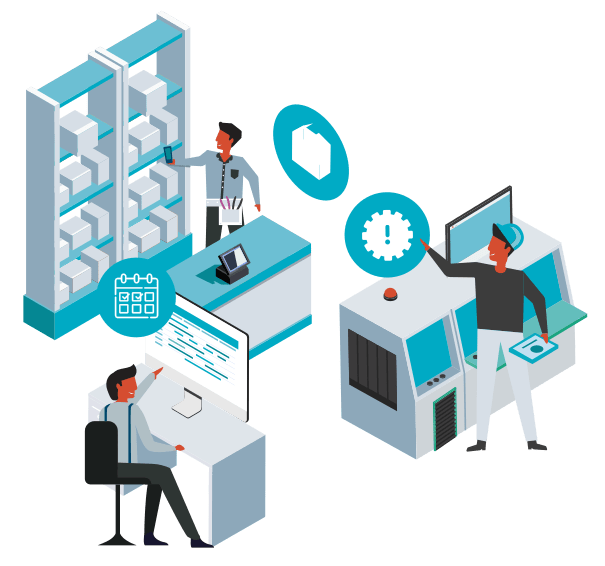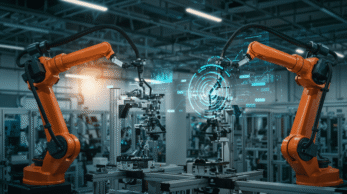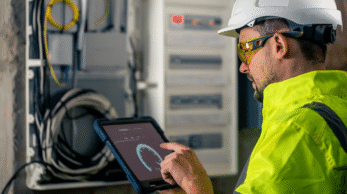In a sector where the quality of life for residents guides all maintenance operations, constantly monitoring the state of its facilities is absolutely essential. Between budget constraints and quality imperatives, nursing homes must develop a reactive industrial maintenance strategy, balancing both intervention costs and the assets themselves, whose wear and tear should not hinder quality. Adopting a maintenance software is particularly necessary to inventory its facilities, optimize the living environment, and better manage care.
The Challenges of Maintenance in the Nursing Home Sector
Ensuring Resident Well-being Above All

The primary mission of a nursing home is, of course, to ensure the living environment of its residents. Minimizing the impact of technical malfunctions on its occupants, who are generally more vulnerable than average, is a priority objective. Parameters such as temperature variations, air quality, and noise disturbances must be constantly monitored. The goal for managers: maintain a stable environment, not subject to unexpected changes.
Maintaining Often Aging Assets
Many nursing homes are located in old buildings, sometimes unsuitable for current requirements. This aging primarily affects everyday systems such as air conditioning, heating, or hot water supply. In the presence of advanced wear signs, maintenance must be even more vigilant. A very detailed monitoring of the operational indicators of these assets is the solution to extend their lifespan or to intelligently plan their renewal.
Limiting Costs
Among the major challenges for nursing homes, significant budget constraints, where the renewal of facilities can weigh heavily. Proactive maintenance management is therefore a substantial savings lever. Cost limitation can be achieved by reducing emergency repairs and more effectively prioritizing interventions according to the criticality of the assets. Operations that require inventorying all assets.
Nursing Home Assets and Their Maintenance Needs
Varied, nursing home assets must be treated according to specific technical constraints for each:
Heating and air conditioning systems are critical elements for resident comfort. Their regular maintenance ensures not only the well-being of the occupants but also contributes to controlling the building’s energy consumption. Preventive maintenance of these systems includes checking filters, leak control, and optimizing settings.
Air extraction and ventilation systems play an essential role in indoor air quality. Their proper functioning prevents the spread of pathogens and maintains a healthy environment. Maintenance of these systems includes cleaning filters, checking motors, and ensuring duct tightness.
Electrical equipment and lighting systems are also important. Regular checks of electrical installations prevent fire or electrocution risks and contribute to the safety of people in the buildings, whether they are occupants or staff.
Sanitary installations (showers, adapted bathtubs, toilets) ensure hygiene and functionality. Industrial maintenance of these assets includes checking tightness, descaling, and controlling assistance systems.
Medical equipment (including patient lifts, medical beds, or call systems) are directly linked to the safety of residents and healthcare staff. Their reliability must be absolute, which involves frequent checks and rigorous preventive maintenance of each.
Finally, fire safety and access control systems should not be forgotten in maintenance, especially since these assets are subject to strict regulations, with mandatory maintenance and documented checks at regular intervals.
Intervening Upstream to Improve Management: The Specialty of Preventive Maintenance
In this context of constant cost pressure and asset sensitivity, only preventive maintenance will allow anticipating future needs. The preventive approach is all the more indicated in the case of nursing homes as it allows:
- Scheduling interventions outside critical hours: in this way, the impact of maintenance on the daily life of the facility will be minimized, allowing technicians to work without interfering with care or resident activities.
- Optimizing the lifespan of assets: Regular maintenance extends the longevity of facilities, thus delaying investments related to their renewal.
- Reducing long-term costs: planned interventions cost 3 to 4 times less than emergency repairs. Preventive maintenance also avoids collateral damage that can occur in the event of major breakdowns.
Often, implementing this preventive approach will involve equipping with specialized software. Nursing homes wishing to gain visibility on their buildings will greatly benefit from relying on tools such as CMMS to inventory all their facilities and make the right decisions.
Maintenance Software, Capable of Adapting to the Specific Needs of Nursing Homes
CMMS indeed meets all the constraints of the nursing home sector and significantly increases the share of preventive maintenance. The maintenance software has several key features for this:
The centralization of maintenance information is the essential asset of CMMS. Assets are thus fully inventoried within a single database: their characteristics, intervention history, and technical documentation are all elements directly available to the maintenance team and managers. This data centralization allows for quicker decision-making as soon as the need arises.
Intervention planning allows establishing a long-term preventive maintenance schedule. Work requests are better tracked and occur quickly after reporting or based on predefined criteria (usage time, anniversary date, number of cycles), with better coordination of maintenance teams.
Spare parts inventory management prevents material shortages and thus asset unavailability. The maintenance software allows real-time stock level tracking and automatically triggers orders when alert thresholds are reached.
Precise budget tracking provides great visibility on maintenance costs, visibility that is even more precise as this maintenance becomes preventive. With expenses better controlled, asset renewal is no longer done in a rush, and needs can be prioritized.
Report production meets the regulatory requirements of the sector. Documents generated by the CMMS will be a reliable support during inspections and certifications, and maintenance reports will be a valuable basis for understanding and acting on facilities at the right time.
Finally, the mobile accessibility of the maintenance software greatly facilitates the work of technical teams in nursing homes. Despite reduced time slots and high mobility conditions for technicians, maintenance data is easy to consult and facilitates on-site intervention within expected timeframes.
Discover the Testimony of the Yonne Departmental Retirement Home and the Creusot Departmental Nursing Home
“Thanks to DimoMaint MX CMMS, we are able to reassure care services about the tracking of their requests. The software provides a significant gain in terms of reactivity by integrating the mobility constraints of agents. Work requests are now available in real-time on their smartphones,” highlights Gaëtan Thomas.
With these features, CMMS frees nursing home managers from the complexity of maintenance. A dedicated software improves service quality and better controls costs through a better understanding of available resources. Nursing home teams thus have more time to allocate to their core business: service and care for the most vulnerable people.





